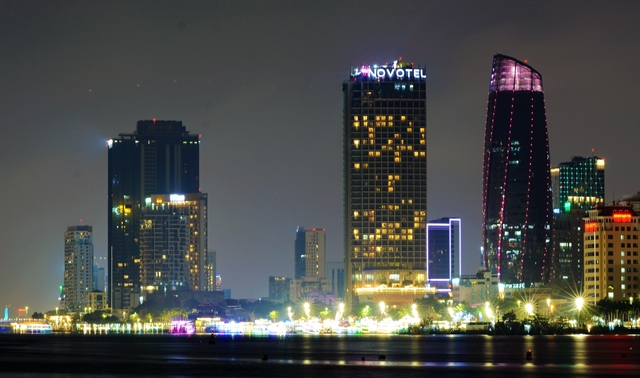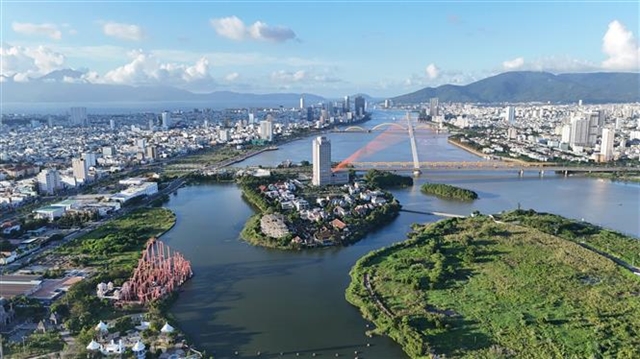Its strategic location near major Asian financial hubs, modern infrastructure, dynamic business environment and high quality of life position it well to become a regional financial node.
HÀ NỘI — Việt Nam is making significant strides toward establishing an International Financial Centre (IFC).
Both local and international experts have praised the country’s strategic decision to avoid concentrating resources in a single location. Instead, Việt Nam is cultivating a dynamic financial ecosystem anchored in HCM City—the nation's economic powerhouse—and Đà Nẵng, the innovation hub of the central region. This decentralised approach holds strong potential to enhance Việt Nam’s position on the global financial stage.
The functional zoning model aims to leverage the distinct strengths of each locality, fostering synergy and promoting balanced regional development.

Việt Nam has long discussed the establishment of an International Financial Centre (IFC) as part of its broader economic and financial development strategies. Under Decision No. 2097/QĐ-TTg issued in 2021, the Prime Minister approved a roadmap for developing Việt Nam’s financial market through 2030, which included studying the feasibility of establishing an IFC in HCM City, with a long-term vision of expanding it into an inter-regional model.
In 2022, HCM City submitted a proposal to the Government, setting an ambitious target of becoming a leading financial centre in ASEAN by 2030. At the same time, Đà Nẵng launched its own initiatives, focusing on institutional experimentation, digital financial services, and regulatory sandbox models.
In early 2024, Đà Nẵng formally proposed its own IFC plan, and on January 4, the Government issued Resolution No. 259/NQ-CP, officially designating both Đà Nẵng and HCM City as the two locations for establishing and operating the IFC, beginning in 2025. The Ministry of Finance and the State Bank of Vietnam have since issued guidance to ensure regional coordination and prevent overlap in implementation.
According to Lê Trung Chinh, Chairman of the Đà Nẵng People’s Committee, after years of groundwork, the Politburo has endorsed the dual-centre model. Land has already been allocated for the centre in Đà Nẵng, and if all proceeds smoothly, the National Assembly is expected to approve the legal framework for Việt Nam’s IFC during its June session.
Richard Dean McClellan, founder and CEO of RMAC Advisory, LLC, noted that Việt Nam’s strategy of diversifying financial development across three major urban centres — Hà Nội, HCM City, and Đà Nẵng — reflects a global trend toward decentralised financial ecosystems.
Under this model, Hà Nội continues to serve as the seat of policymaking and governance. HCM City retains its role as the country’s financial and investment hub, and Đà Nẵng is positioned as a testing ground for innovative financial initiatives, strategically located in central Việt Nam.
Đà Nẵng has emerged as a key player in Việt Nam’s financial innovation strategy.
With its strategic location near major Asian financial hubs, modern infrastructure, dynamic business environment, and high quality of life, Đà Nẵng is well-positioned to become a regional financial node.
According to Associate Professor Dr. Đặng Tùng Lâm of the University of Economics – University of Đà Nẵng, plans to establish a free trade zone in the coastal city represent a strategic move toward deeper financial and commercial integration.
In practice, Đà Nẵng is already leading in three critical areas: green finance aligned with the Sustainable Development Goals, trade finance powered by a free trade zone model that enables regulatory flexibility, and digital finance and innovation, driven by sandbox mechanisms that allow for the safe experimentation of new financial technologies.
With the IFC in place, Đà Nẵng will attract significant capital inflows, providing a powerful engine for local development, said Chinh.

Open Lab for financial innovation
The sandbox mechanism is emerging as a key driver in Việt Nam’s financial innovation ecosystem.
According to Ben El-Baz, CEO of HashKey Group (Hong Kong, China), sandbox environments allow fintech startups and innovators to test new ideas and business models without the constraints of traditional financial regulations. Crucially, they also foster public-private collaboration, helping refine both product offerings and the legal framework.
Việt Nam has institutionalised this mechanism through Decree No. 94/2025/NĐ-CP, issued on April 29, 2025, and effective from July 1, 2025.
The decree establishes a controlled trial framework (sandbox) in the banking sector, allowing credit institutions and fintech firms to pilot three categories of services: credit scoring, data sharing via open APIs, and peer-to-peer (P2P) lending. Each trial is limited to two years, with the possibility of extension. Participants must operate within their licensed scope, submit periodic reports, manage risk effectively, and ensure consumer protection.
This regulatory framework lays the foundation for a modern financial ecosystem aligned with global service trends. Việt Nam is among the first in the region to enshrine sandbox regulations in banking law—an important step toward broader financial innovation.
However, as Associate Professor Dr Phan Dũng of the Foreign Trade University pointed out, further expansion is needed. For example, opening APIs would allow businesses to integrate financial services directly into tech platforms, creating new business models that respond to diverse market demands while remaining under appropriate regulatory oversight.
This focus on institutional experimentation, rather than infrastructure alone, reflects Việt Nam’s forward-thinking approach to its International Financial Centre (IFC) strategy. The dual-location model helps reduce pressure on any single city while enhancing national flexibility in responding to global financial shifts.
Within this model, Đà Nẵng serves as an “open laboratory” — a space to test innovative products, policies, and technologies before rolling them out on a national scale.
For the dual-centre approach to succeed, experts emphasised the importance of clearly defined roles for each location. As Dr Đặng Tùng Lâm noted, the goal is not internal competition but strategic complementarity, with each city contributing its unique strengths to a unified national vision.
Equally essential is coordinated investment in both “hard” and “soft” infrastructure, including logistics, smart transport, urban financial spaces, digital technology, institutional agility, and the development of a highly skilled workforce. These foundational elements are crucial to building true global competitiveness.
If implemented effectively, Việt Nam could secure a prominent position on the global financial map within the next 10 to 15 years, according to Richard Dean McClellan.
Experts agree that Việt Nam has the potential to become a launchpad for the next generation of financial innovation. Strategic vision, flexible execution, and open collaboration will be critical to shaping a sustainable financial future for Việt Nam in this era of transformation. — VNS





